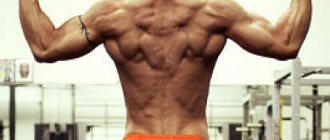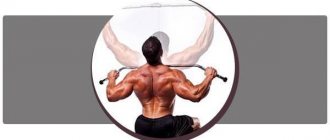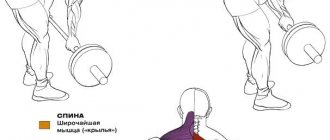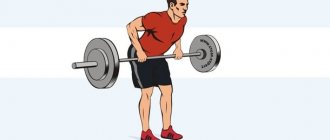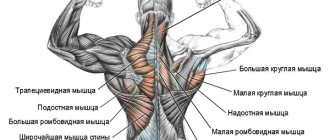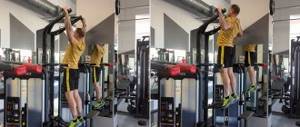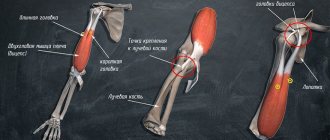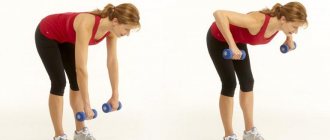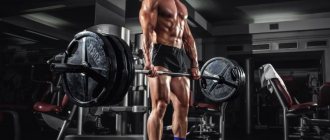What is the best and most versatile exercise for developing almost all the muscles of the body? Push ups? No! Maybe squats? Also no! Reverse grip pull-ups? Also no! There is no universal exercise that works all muscle groups. But the most useful and effective is actually pulling your own body towards a vertical bar.
Are there any contraindications?
Before reading further, make sure that you are not part of the group of people for whom reverse grip pull-ups are contraindicated.
- any curvature of the spine. Kyphosis, scoliosis, lordosis;
- unevenly developed muscle corset;
- lumbar injuries;
- back muscle strain;
- osteoporosis;
- osteochondrosis;
- postoperative injuries in the back;
- pregnancy;
- problems with the abdominal muscles;
- prolapsed hernia;
- postoperative injuries in the abdominal cavity;
- pregnancy.
All contraindications are strict, since in this case, pulling your own body towards the crossbar causes irreparable harm to the body and can even cause disability!
Otherwise, pull-ups on the horizontal bar with a reverse grip do not have any strict contraindications from the cardiac or vascular system.
What, why and how?
Why do pull-ups with a narrow reverse grip? Firstly, this is a basic exercise that involves the maximum possible number of joints, and leads to an increase in testosterone, in addition to this:
- Strength pull-ups stretch the spine, relieving pinching;
- Develop a back corset;
- They are an excellent prevention of spinal curvature;
- They can be performed without special equipment;
- Do not require special training;
- Works the biceps muscles;
- Develop a static grip;
- Increases overall muscle mass.
All these factors make it indispensable in:
- Speed and strength sports;
- Martial arts;
- Yoga;
- CrossFit;
- Bodybuilding;
- Powerlifting.
Well, perhaps it’s worth noting the fact that among all the exercises that involve the upper and lower back, close-grip pull-ups without weight are the only ones that are completely safe and work the biceps. Since the reverse grip pull-up is a base that has a good effect on the biceps, which muscles do not work as the main ones need to be additionally worked with the help of isolating ones. For example, after pull-ups it’s good to use:
- Pull of a vertical block behind the head;
- Front thrust of the horizontal block;
- Shrugs with a barbell behind your back;
- Concentrated dumbbell curls for biceps;
- Working in a rowing machine;
- Work with crossover for biceps.
In this case, the benefits of pull-ups will be maximum. And don't forget about weights. After reaching a certain threshold (for example, 30 pull-ups per set), you can hang plates or chains on yourself.
Other types of pull-ups
Pull-ups with a narrow grip (as well as too wide) are undesirable. Firstly, it will be awkward to pull yourself up as the joints will move into an unnatural position, increasing the risk of injury. And secondly, the elbows will move apart on their own, which means the technique of doing the exercise will suffer.
If, during the execution, you change the reverse grip when pulling up to a straight one, the load on the brachialis, a muscle that helps increase the volume of the biceps, will increase.
Beginners wonder how many times to do pull-ups. It depends on what the athlete's goals are. If he wants to build muscle mass, he should do the exercises slowly, in 2-4 sets, 8-12 times. But endurance is pumped up by the number of quick repetitions until the moment when the hands begin to tremble, that is, until complete failure.
The exercise in question can be performed anywhere: in the gym, at home, on sports fields. To get a greater effect from training, it is recommended to alternate exercises: use pull-ups with different grips, which develop not only the muscles of the arms, but also the back and shoulders. For example, the exercise can be performed with a neutral (or parallel) grip. This is when the palms face each other. This exercise is performed either on parallel bars or on a horizontal bar with an end rail equipped with handles for a neutral grip. To have a complete understanding of the technique, it is recommended to watch thematic videos on the Internet.
There is another type of pull-up with a reverse grip: bottom. When the athlete brings his legs forward and hangs from below, almost along the crossbar. By pulling yourself up in this way, the individual's biceps and abdominal muscles are pumped. Therefore, this technique can replace the abdominal pumping exercise.
What muscles work?
Pull-ups on the horizontal bar with a reverse grip are a basic multi-joint exercise, thanks to which the muscles of the spinal block are pumped.
| Muscle group | Load type |
| Latissimus dorsi muscles | Active |
| Biceps flexor muscle | Active |
| Abdominal muscles | passive |
| Psoas muscles | Passive |
| Rhomboid muscles | Active |
| Lower trapezius (more trapezius exercises) | Active |
| Forearm muscles | Passive |
Debunking the Myths – Narrow Vs Wide Grip
There is a myth that wide-grip pull-ups are more beneficial to the body than close-grip pull-ups . Let's try to figure it out: is this so? If we consider the mechanics of pull-ups with a reverse grip, then when working with a wide grip, the amplitude of movement decreases, due to which the lats are strained more, but at the same time they are not worked as deeply. In addition, with a wide grip, the rhomboid muscles are practically not used; instead, the lower trapezius takes the load. But there is a main difference - with a fairly wide grip on pull-ups, the angle in the hands becomes unnatural for the elbow joint, which leads to its rapid wear. As for the narrow grip, when working:
- The amplitude of movement expands, which provides deeper work on the back muscles;
- In the upper phase of the movement, the muscles that bring the arm forward (internal pectoral bundles) are partially activated;
- There is no traumatic danger to the elbow joint;
- The load is evenly distributed between the rhomboids and the lats.
- The biceps flexor muscle is used to the maximum.
If we consider pull-ups with a direct or reverse grip, then the situation is exactly the opposite. On the one hand, a direct grip with the correct technique completely disables the biceps flexor of the arm from working. This puts more stress on the back muscles - which allows you to make it thicker and wider. The main load falls exclusively on the latissimus muscles, while the amplitude is somewhat less than in the opposite case. The opposite is true - it connects additional muscle groups to the movement and increases the joint load. Those. for overall progress it is much more effective, since the body finds itself in a more stressful situation. As for the development of the back muscles, due to the “eating” of the load by the biceps, the back is worked out less.
Pull-ups with a grip along the horizontal bar. Technique and muscles
The list of what makes a close-grip pull-up on a horizontal bar includes mainly the lower part of the latissimus muscle and the muscles located near the spinal column. A small load also applies to the serratus muscle tissue. To correctly perform pull-ups with a narrow grip, you need to know the technique of performing the exercise and its types:
- Pull-up with a narrow straight grip. In this case, the palms are facing away from you. The main tension is on the biceps;
- Pull-up with a narrow reverse grip. He is characterized by palms facing himself. If you do pull-ups like this on the horizontal bar, you will notice that the back muscles are worked out in the best possible way.
It is advisable to find out what grip is best for doing pull-ups on the horizontal bar and how to do it from professional trainers or search for information on the Internet. If you follow all the instructions exactly, you can achieve the desired effect in a short time. However, if you have health problems, you will need to first consult with your doctor.
This is the most famous multi-joint exercise that can give the male figure the desired V-shape. When performing wide-grip pull-ups, the main load is concentrated in the upper region of the latissimus muscles. Of all the types of horizontal bar grips, this one is the most difficult to perform. Improper technique can result in serious injury.
Execution rules:
- Grasp the bar as you would with a classic overhand grip pull-up, but with a wider wrist position. Keep your body straight and arms fully straight.
- As you exhale, begin to pull your body up, squeezing your shoulder blades and lowering your elbows down and back. At the top point, the chest should touch the horizontal bar (or be very close to it). Take a short break, feeling the tension in the latissimus muscles as much as possible.
- Inhaling, slowly return to the starting position.
- Complete the planned number of pull-ups.
Recommendations:
- Do not pull your body with your arms, try to strain the latissimus muscles as much as possible.
- Having reached the top point of the amplitude, lower down slowly, without jerking. This recommendation applies to all types of these exercises, not just the ones we described in this section.
This type of exercise is performed to work the teres major and latissimus dorsi muscles. Despite its effectiveness, this movement is very dangerous, so you must do it at your own peril and risk.
Technique:
- Starting position on the horizontal bar: straight grip, wide arms, the angle between the shoulder and forearm is approximately 45 degrees. Hang from the bar so that the back of your neck is level with the bar. Tilt your head slightly forward and down.
- As you exhale, pull yourself up until your head is above the horizontal bar. Pause for a second.
- As you inhale, slowly return to the starting position.
- Do as many pull-ups as you need.
This exercise is not recommended for people with injuries to the cervical and shoulder girdle, since during execution there is a serious load on these areas.
What muscles are affected by pull-ups on the horizontal bar with a reverse grip? As we said earlier, this exercise is often used to train the biceps.
Technique:
- Grab the bar with an underhand grip, shoulder-width apart. Do not place your arms too wide so that the lats do not “eat up” the main load.
- As you exhale, pull yourself up. Pause at the top for one to two seconds.
- Inhaling, slowly lower yourself down.
- Pull yourself up the required number of times.
With this positioning of the hands, the lower lats work well. The lateral and anterior bundles of the deltoid muscles receive indirect load.
Technique:
- Grab the bar so narrowly that the thumbs on both hands touch. Bend your back slightly at the lower back, leaving your arms slightly bent in the lower position.
- As you exhale, do a pull-up.
- Inhaling, lower yourself down.
- Repeat the movement as many times as you planned.
Pull-ups can be performed in different ways. In this case, methods mean changing the grip: its width, the location of the hands on the crossbar. There are other ways to vary the load when performing pull-ups. For example, changing the time of the negative and positive phases, using additional weights, the technique of incomplete amplitude (partial repetitions).
But it is precisely working with different grips of the bar that allows you to optimally redistribute the load between individual muscle groups and effectively avoid the occurrence and development of muscle adaptation. There are 4 main grips: regular (aka upper, medium in width), wide, parallel and reverse grip (narrow).
Depending on the width and method of grip, you can practice on the horizontal bar as follows:
- narrow overhand grip (brachialis, serratus anterior and lower lats)
- narrow reverse grip (biceps, lower lats)
- medium straight grip (muscles of the back, shoulders and chest)
- medium reverse grip (lats, biceps)
- wide grip to the chest (top of lats, trapezoid, round)
- wide grip behind the head (trapezius, upper and middle part of the lats, round)
- neutral grip (lats, triceps, brachialis, serratus anterior)
The wider the grip, the more the back muscles work. The narrower the grip, the more the muscles of the arms and chest are activated.
Now let's look at the basic grips in more detail.
Width – slightly wider than shoulder width, overhand grip (palms facing outwards). At top dead center, the arms are fully bent at the elbow joint, the chin is above the bar. At bottom dead center, the arms are fully extended. The exercise should be performed without swinging, the negative phase (lowering of the body) is a controlled descent.
Typically, the negative and positive phases of the exercise are performed at the same speed, however, the biceps are more sensitive to the negative phase of the load, so many athletes recommend performing the negative phase approximately twice as long as the positive phase. If an athlete cannot pull himself up on his own, then a partner helps him with this, lifting him up and allowing him to slowly lower himself (using the controlled descent method) - this is one of the ways to learn how to pull himself up. In regular grip pull-ups, the biceps, trapezius and latissimus dorsi muscles are evenly loaded.
With a lower grip, the load shifts more to the biceps. Pull-ups with this grip are easier to perform if you have weak lats but sufficiently developed biceps. Therefore, this grip is often used by beginners and people whose goal is to train the biceps muscle.
In order to take an underhand grip, you need to place your hands behind the bar with your palms facing away from you, turn your hands inward and grab the bar. There is no need to laugh and say, like “What a useless article, why don’t we know how to use an underhand grip?”
You can do pull-ups with a narrow or medium grip. You can also do partial pull-ups specifically to train your biceps. That is, pull up to an incomplete amplitude. The fact is that the latissimus muscles work mainly at the beginning of the lift, and then the main load falls on the arms.
Therefore, if you lower yourself not to the end, but to the middle (so that the arm at the elbow forms a right angle), the load on the lats is almost completely removed, and the biceps is in constant tension.
Hands on the horizontal bar are positioned narrower than shoulder width with palms facing toward you. The thumb is opposite the rest. During pull-ups, you need to move your shoulders back and bring your shoulder blades together. You should try to touch the bar with your lower chest.
When doing pull-ups with a narrow lower grip, the following muscle groups are trained:
- biceps;
- lower part of the latissimus dorsi muscles.
Hands are positioned shoulder-width apart. Palms facing yourself. The thumb and the rest form a “lock.” The pull-up technique is the same as in the previous case: during the lift, the shoulders are pulled back, the shoulder blades are brought together, you need to touch the bar with the lower chest.
This grip is not particularly suitable for training muscles, but it is used in some elements of street workout, for example, in the angel walk. Reverse grip pull-ups are usually performed not to develop strength, but to develop flexibility in the hands.
With a reverse grip, you can pull yourself up either in front of you or behind your head. Moreover, it is easier to pull yourself up by your head. And in order to do pull-ups in front of you, you need very flexible hands.
In order to grab the horizontal bar with a reverse grip, you need to place your hands behind the bar with your palms facing away from you, turn your hands outward and grab the bar.
You can only pull yourself up with a reverse grip with your arms spread wide.
With this grip, the axis of the athlete’s body is not perpendicular to the plane of the horizontal bar, but parallel to it. The view is located along the horizontal bar.
One hand should be taken with an overhand grip, the other with an underhand grip. Hands are located nearby. The thumb grips the bar. With this grip, your body will naturally align along the horizontal bar.
In principle, this grip is a copy of the parallel grip, only it is carried out on one bar, and not on two.
Technique
Reverse grip pull-ups are considered both the simplest and most difficult exercise in sports disciplines. It's simple - the fact is that many athletes use their elbows incorrectly.
Correct technique for reverse pull-ups:
- Hang on the horizontal bar.
- The grip should be shoulder-width apart;
- Hands perpendicular to each other;
- The first pull-up is done in a smooth mode;
- You need to pull with your elbows and not your wrists;
- The pull-up is carried out until the chest touches the bar;
- At the top point, linger for 1-2 seconds;
- Then lower yourself without bringing your elbows to maximum extension.
If you have additional weights (in the form of chains), you need to monitor your breathing (inhale in the lower phase, exhale in the upper) and the position of the body. In particular, due to the shift in the center of gravity, it is necessary to take into account the angle of elevation and forcefully maintain a deflection in the lower back. When working without weight, the lower back automatically assumes the correct position.
Errors
Despite the extremely simple technique, there are a number of mistakes that most athletes make, which is why pull-ups on the horizontal bar with a reverse grip lose most of their effectiveness.
Mistake #1 – wrist thrust. In this case, the load falls entirely on the biceps, while the back rests. Pull-ups are transformed from a basic exercise into an isolated exercise.
Mistake #2 – bending your legs or changing your body position. Many people, when they cannot pull themselves up, begin to pull their body towards themselves, changing the center of gravity and involving the abdominal muscles in the movement. This should absolutely not be done, since the lumbar region at this time is in a stretched state, and it is very easy to get a sprain or a pinched ligament.
Mistake No. 3 – under no circumstances should you twitch on the horizontal bar. For the reasons described in error No. 2
Mistake #4: Using a grip that is too wide. In this case, the elbow joint works in an unnatural amplitude, which can result in dislocation and even fracture;
Mistake #5 – Full elbow extension. This is the most common mistake made by beginners. It seems to them that in this case they get a fuller load. However, this is not true. In this case, most of the forces are not spent on contracting the back muscles, but on overcoming the ligament barrier of “30 degrees”.
The main mistake: doing pull-ups in an explosive style. It is believed that this way the muscles are loaded more. This is true, and there is an opportunity to swing faster, get more pumping and, most importantly, use fast-twitch fibers. But this poses a serious risk of spinal injury due to its stretched state. In particular. Because of this, you can easily get a pinched spinal disc.
Common mistakes
It is quite common for a person to have a high level of motivation to exercise. He gets inspired and starts doing the exercises at a very fast pace. At best, this simply reduces the effectiveness of the workout, and at worst, it injures you. This results in you being unable to exercise for several weeks. If you don't want this, you need to avoid the following mistakes when performing pull-ups.
- Involving the lower body in the work is a common mistake for beginners. That is, if you pull yourself up using a leg jerk, the muscles of your back and arms are only half loaded.
- Exercising too quickly will not only reduce the effectiveness of your workout, but also increase the risk of injury. The ideal pace for doing pull-ups is medium.
- Straightening your arms at the bottom also reduces the effectiveness of the approach. First, it contributes to wear and tear on the shoulder and elbow joints. Secondly, by fully extending your elbows, you will be able to do fewer repetitions.
- Head movements are a very dangerous mistake that can lead to injury to the neck muscles. When doing pull-ups, the head should not be tilted, but the gaze should be directed forward. If it is more convenient for you to look up when doing pull-ups, you can tilt your head back half a centimeter and raise your eyes.
- Incorrect breathing. Beginners often hold their breath during the approach. This cannot be done, because it can worsen the functioning of the heart and respiratory system. Remember, effort should be on the exhale, and relaxation should be on the inhale.
Bottom line
Regardless of whether you decide to use a forward or reverse grip pull-up, stick to the correct technique, or better yet, alternate between both of these exercises. Only in this case will the load on the back muscles be distributed evenly. If you notice that one side of your back is not developing as quickly as the other, compensate for the load with pull-ups on one arm, or use unilateral rows to the dumbbell belt
Close-grip pull-ups
This version of pull-ups maximally loads the arm muscles. The back works less in this version. By the way, in the second half of the amplitude, the back muscles stop working altogether. The narrower the grip, the more isolated the biceps work.
It should be remembered that an excessively narrow grip harms the ligaments of the wrist joints.

